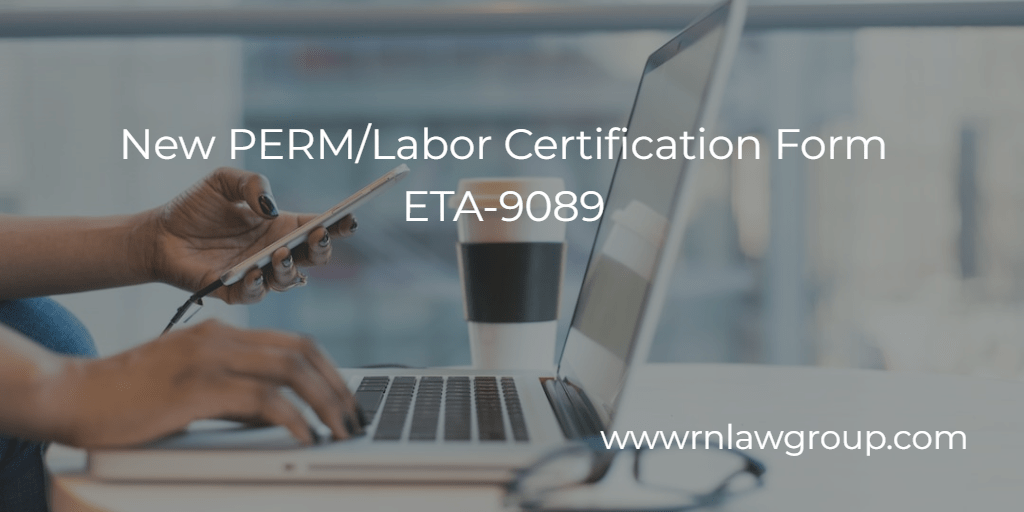
New PERM/Labor Certification Form ETA-9089
The PERM/Labor Certification process is usually the first step in the employment-based green card process. The process is designed to ensure that there are no qualified U.S. workers available for the sponsored position and that the foreign worker will not negatively impact the wages and working conditions of U.S. workers.
For the preparation and submission of PERM applications (Form ETA-9089), the Office of Foreign Labor Certification (OFLC) used the Permanent Online System. However, as of June 1, 2023, employers filing PERM applications must submit the ETA-9089 through the Foreign Labor Application Gateway (FLAG) system.
The Form ETA-9089’s structure and content have changed as part of OFLC’s transition of the PERM program to FLAG. The new form aims to streamline the PERM/Labor Certification process and increase efficiency in the Department of Labor’s (DOL) application review process.
Below is a list of the major changes made to the Form ETA-9089.
- The new form asks preliminary questions about the type of occupation and if the employer is required to undergo supervised recruitment.
- The new form asks for the number of employees on payroll in the area of intended employment (as opposed to the total number of employees).
- The new form includes a question regarding dual representation (whether the employer has contracted with an agent or attorney that also represents the foreign worker).
- The employer no longer manually enters the information included on the Prevailing Wage Determination (PWD). Instead, the employer links the PWD to the Form ETA-9089. The job description and minimum requirements of the job opportunity are no longer shown on the new form.
- The employer may now describe any conditions about the offered wage including any bonuses, fringe benefits, subsidized housing or meals, or any other benefits associated with the job opportunity.
- The new form asks for the type of worksite location (i.e., the employer’s business premises, the employer’s private household, the employee’s private residence, or if there is no one specific worksite address). For all worksite locations, the new form asks for the MSA/OES area code and title. The new form also allows employers to describe circumstances where the worksite is not known, the areas of intended employment are dispersed over a wide geographic area, or if the job opportunity requires roving, travel, or possible relocation.
- The new form asks if the foreign worker qualifies for the job opportunity by the virtue of the employer’s alternative requirements. If so, the form asks if the employer is willing to accept any suitable combination of education, experience, or training (Kellogg language).
- The new form includes a separate section for training and a separate section for special skills. The employer is required to identify the training or special skills the foreign worker possesses if such training or special skills is required for the job opportunity.
- The new form requires employers to provide supplemental information and to explain the business necessity of the requirements when answering “Yes” to the following questions:
- Does the job opportunity require the worker to live on the employer’s premises?
- Does the job opportunity involve a combination of occupations?
- Is proficiency in a foreign language required or preferred to perform the job duties?
- Do the job requirements exceed the Specific Vocational Preparation (SVP) level assigned to the occupation as shown in the O*NET Job Zones?
- Did the employer use a credentialing service to qualify the foreign worker’s education and/or experience requirements?
- Has the employer received payment of any kind for the submission of this application?
- Has the employer had a layoff in the occupation involved in the application or in a related occupation within the 6 months immediately preceding the filing of the application in the area of intended employment?
Reddy Neumann Brown PC. is dedicated to helping our clients navigate the U.S. business immigration system. Because the U.S. business immigration system can be tricky, it is always best to contact a qualified immigration attorney to help come up with the proper solution for each individual case.
By: Camille Joson
Camille Joson is a Senior Associate Attorney in Reddy Neumann Brown PC’s PERM Labor Certification Department, where she assists clients in the beginning stages of the green card process.

